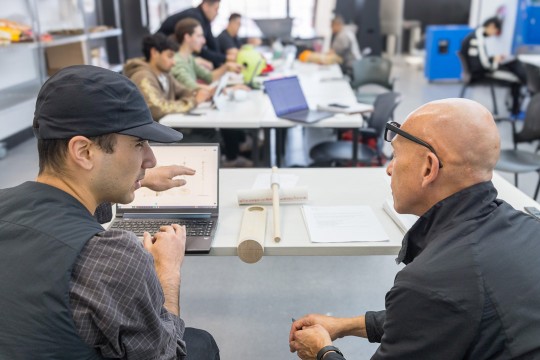Students take research trip to Honduras
RIT students visited Hospital Escuela for research projects they're working on.
Capstone projects in development with RIT Hope for Honduras, interior design program chair and assistant professor Mary Golden’s research initiative, are picking up steam.
Representing various project groups, four RIT students and Golden advanced three current multidisciplinary capstones and collected information for the other five projects underway by taking an enlightening research trip in October to Honduras. Three of the students who traveled are from the College of Art and Design and the other is from the Kate Gleason College of Engineering (KGCOE). The projects, in various stages of progression, use a Science, Technology, Engineering, Arts and Mathematics (STEAM) approach.
The capstone endeavors derive from the RIT interior design program’s collaboration with Little Angels of Honduras (LAH), a nonprofit organization dedicated to reducing infant mortality in the Central American country. Last academic year, under the guidance of Golden and adjunct faculty Shannon Buchholtz, interior design students supplied LAH with proposed interior packages for its campaign to build a 4,200-square-foot neonatal intensive care unit addition at Hospital Escuela, Honduras’ largest public hospital. Included were designs for preemie examination tables and a mobile education unit.
For one of the latest phases of the RIT Hope for Honduras initiative, Golden and students Alexa Boyd (interior design), Hannah Lutz (industrial design), Boris Shirman (photojournalism) and Victoria Tripp (mechanical engineering) were hosted by LAH co-founders Christian Perry and Dr. Alejandro Young in Honduras. Their intensive, informative trip spanned from Oct. 5-9, and Golden said the RIT group was able to experience the culture and gain a better understanding of the problems at hand.
Students toured Hospital Escuela, spoke with doctors, nurses and ambulance drivers, and shadowed in the neonatal intensive care unit, observing the conditions and context surrounding their respective assignments.
“We had very full days of research and activities at the hospital,” Golden said. “We were treated like family by our hosts. For some, this was their first study abroad and first time traveling without their parents. The students had unprecedented access to the hospital, staff and facilities to educate themselves about the issues facing the country and in particular, Hospital Escuela. A majority of the students from the capstones want to go to Honduras to present their final projects.”
LAH’s core mission is to bring optimal conditions for maternal and infant care to Honduras, where the existing high maternal-infant mortality rates are traced to a dearth of space and medical equipment hindering the care quality. RIT’s Honduras trip benefitted the following ongoing, multidisciplinary student projects that support LAH’s goals:
An intra-hospital neonatal ambulance (industrial design, interior design and multidisciplinary senior design or MSD)
An emergency incubator resuscitation kit (industrial design and MSD)
A skin-to-skin incubation device (an industrial design studio and graphic design studio are working collectively to design devices and instruction sheets)
A photojournalism story (School of Photographic Arts and Sciences)
To make the Honduras journey happen, Golden said she worked with Dr. James Myers, associate provost of international education and global programs for RIT Global; Dr. Jeremy Haefner, RIT provost and senior vice president for academic affairs; Robin Cass, College of Art and Design interim dean; School of Design administrative chair Peter Byrne; and chairs and deans from the engineering departments. A grant secured by industrial design graduate director and associate professor Alex Lobos, along with contributions from several departments, provided travel funding.
Other recent developments — both in Honduras and otherwise — that have boosted the RIT Hope for Honduras project are:
The Hospital Escuela addition proposals completed by 2016-17’s interior design seniors were reviewed by LAH and Hospital Escuela partners. Golden, interior design graduate Jennets Tho and Perry prepared a final version of one of those interior packages, and according to Golden, it was met with positive reviews from Hospital Escuela directors.
Golden and her group have been requested to broaden the expansion and renovate an area on another floor of Hospital Escuela. That prompted them to organize a small design team and compile revised construction documents for submission by the March 1, 2018, funding review deadline. If the project is funded, according to Golden, the buildout of the 12,000-square-foot neonatal intensive care unit is slated to be finished by 2020.
Golden signed a memorandum of understanding with Universidad Tecnologica de Honduras to work together moving forward. As partner schools, Golden said RIT will hold workshops at the Honduras university, during which Kate Gleason College of Engineering assistant professor Iris Asllani is set to instruct on the repair and maintenance of medical equipment.
Golden said there are upcoming access technology projects associated with RIT Hope for Honduras that will undergo further development in collaboration with Autodesk and a growing list of collaborators.







